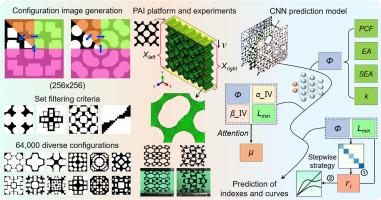基于多模态CNN的复杂构型机械超材料力学性能预测
IF 9.4
1区 工程技术
Q1 ENGINEERING, MECHANICAL
International Journal of Mechanical Sciences
Pub Date : 2025-09-21
DOI:10.1016/j.ijmecsci.2025.110872
引用次数: 0
摘要
机械超材料的宏观力学性能受其微观结构几何形状的强烈影响。然而,有效和准确地预测这些属性仍然是一个重大挑战,特别是对于具有高度多样化配置的大规模数据集。本研究引入了一种新的基于图像的多模态深度学习框架,该框架将结构图像与辅助指标相结合,从而能够同时预测离散性能指标和完整的力-位移(F-D)曲线。为了实现这一目标,我们构建了一个包含64,000个单元格图像(孔隙度Ф∈[0.3,0.8])的高分辨率数据库,并开发了一个自动化的Python-Abaqus平台,能够在大约3秒内完成单个配置的完整有限元分析过程,从而大大提高了建模和计算效率。使用三个代表性CNN骨干网的系统评估表明,多模态异常模型优于ResNet50和VGG16,与单模态输入相比,实现了更高的精度。对性能指标的预测精度较高(R2≈0.97-0.99)。此外,通过整合结构敏感辅助指标和注意机制,将泊松比的预测精度从R2 = 0.88提高到0.93,有效地捕捉了微观结构敏感响应特征。对于曲线预测,验证集上面积比度量的平均值为1.01,能够准确反映非线性响应行为。提出的框架显著推进了机械超材料性能预测和智能设计方法的发展。本文章由计算机程序翻译,如有差异,请以英文原文为准。

Mechanical property prediction of complex-configuration mechanical metamaterials based on multimodal CNN
The macroscopic mechanical properties of mechanical metamaterials are strongly influenced by their microstructural geometries. However, efficient and accurate prediction of these properties remains a significant challenge, especially for large-scale datasets featuring highly diverse configurations. This study introduces a novel image-based multimodal deep learning framework that combines structural images with auxiliary indices to enable the simultaneous prediction of discrete performance indices and complete force-displacement (F-D) curves. To achieve this, we have constructed a high-resolution database comprising 64,000 unit-cell images (porosity Ф ∈ [0.3,0.8]) and developed an automated Python–Abaqus platform capable of completing the full finite element analysis process for a single configuration in approximately three seconds, thus significantly enhancing both modeling and computational efficiency. Systematic evaluations using three representative CNN backbones demonstrate that the multimodal Xception model surpasses both ResNet50 and VGG16, achieving considerably higher accuracy compared to unimodal input. High prediction accuracy is attained for performance indices (R2 ≈ 0.97–0.99). Moreover, by integrating structure-sensitive auxiliary indices and an attention mechanism, the prediction accuracy of Poisson’s ratio is enhanced from R2 = 0.88 to 0.93, effectively capturing the microstructure-sensitive response characteristics. For curve prediction, the average value of the area ratio metric on the validation set is 1.01, accurately reflecting nonlinear response behaviors. The proposed framework significantly advances the development of performance prediction and intelligent design methodologies for mechanical metamaterials.
求助全文
通过发布文献求助,成功后即可免费获取论文全文。
去求助
来源期刊

International Journal of Mechanical Sciences
工程技术-工程:机械
CiteScore
12.80
自引率
17.80%
发文量
769
审稿时长
19 days
期刊介绍:
The International Journal of Mechanical Sciences (IJMS) serves as a global platform for the publication and dissemination of original research that contributes to a deeper scientific understanding of the fundamental disciplines within mechanical, civil, and material engineering.
The primary focus of IJMS is to showcase innovative and ground-breaking work that utilizes analytical and computational modeling techniques, such as Finite Element Method (FEM), Boundary Element Method (BEM), and mesh-free methods, among others. These modeling methods are applied to diverse fields including rigid-body mechanics (e.g., dynamics, vibration, stability), structural mechanics, metal forming, advanced materials (e.g., metals, composites, cellular, smart) behavior and applications, impact mechanics, strain localization, and other nonlinear effects (e.g., large deflections, plasticity, fracture).
Additionally, IJMS covers the realms of fluid mechanics (both external and internal flows), tribology, thermodynamics, and materials processing. These subjects collectively form the core of the journal's content.
In summary, IJMS provides a prestigious platform for researchers to present their original contributions, shedding light on analytical and computational modeling methods in various areas of mechanical engineering, as well as exploring the behavior and application of advanced materials, fluid mechanics, thermodynamics, and materials processing.
 求助内容:
求助内容: 应助结果提醒方式:
应助结果提醒方式:


